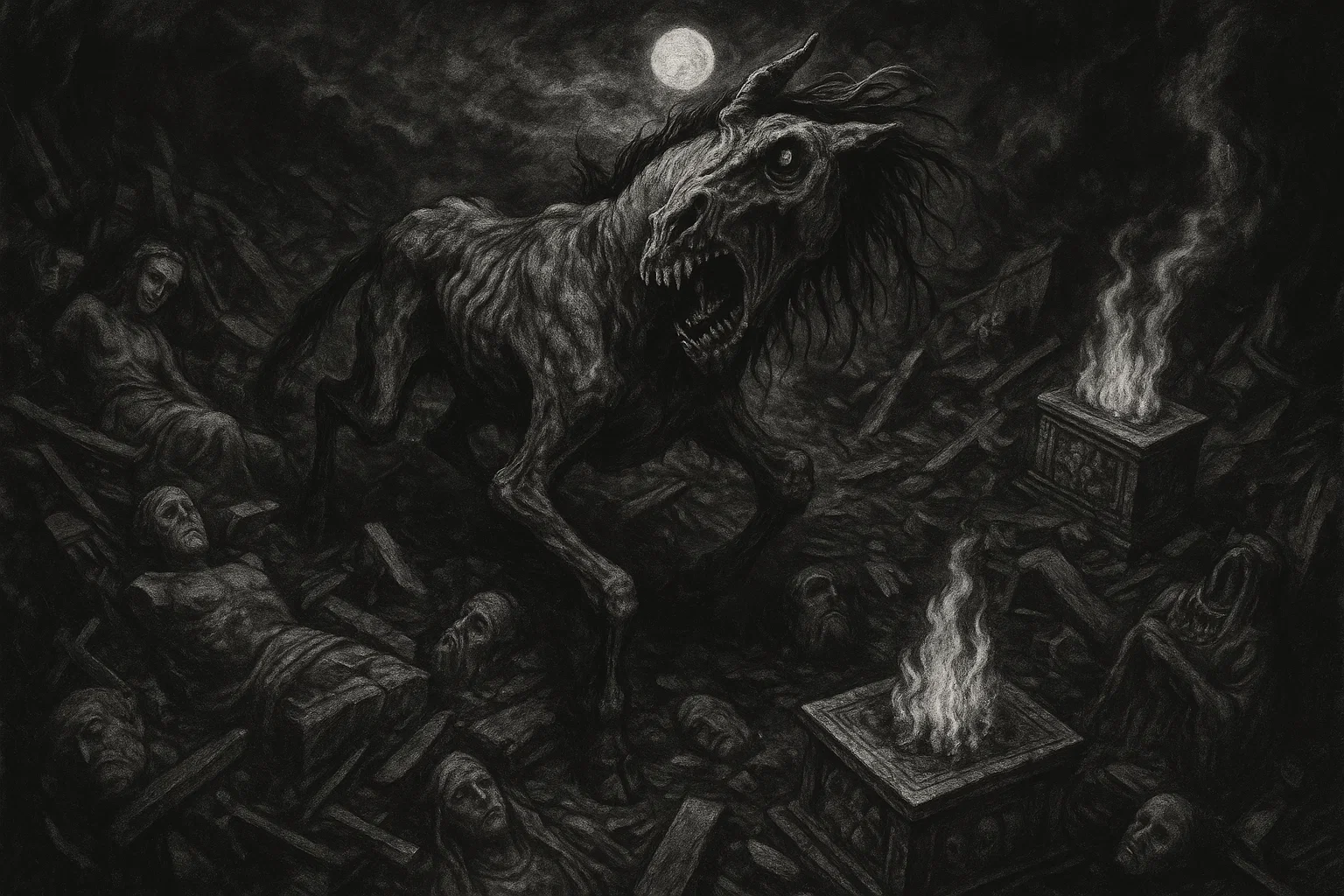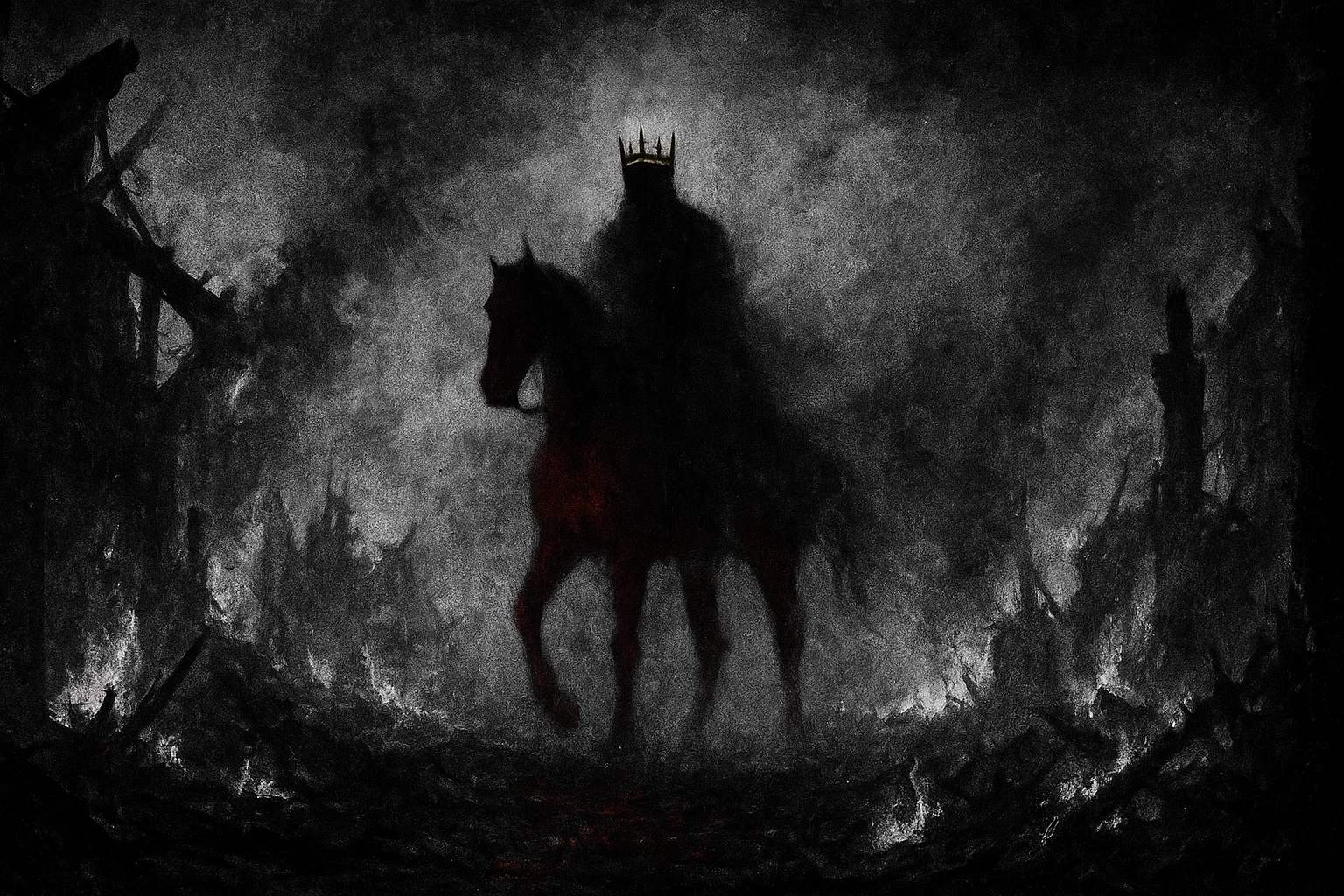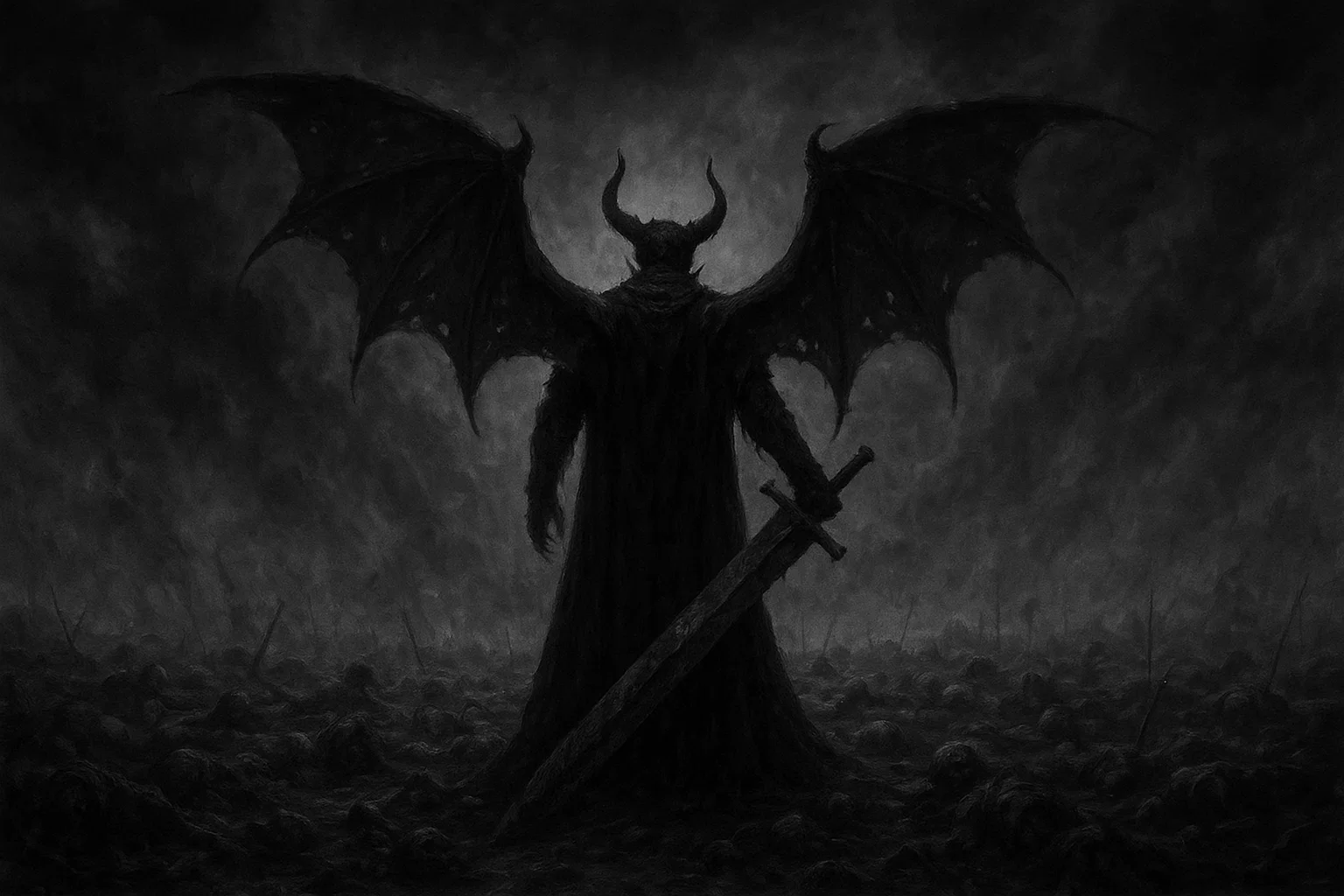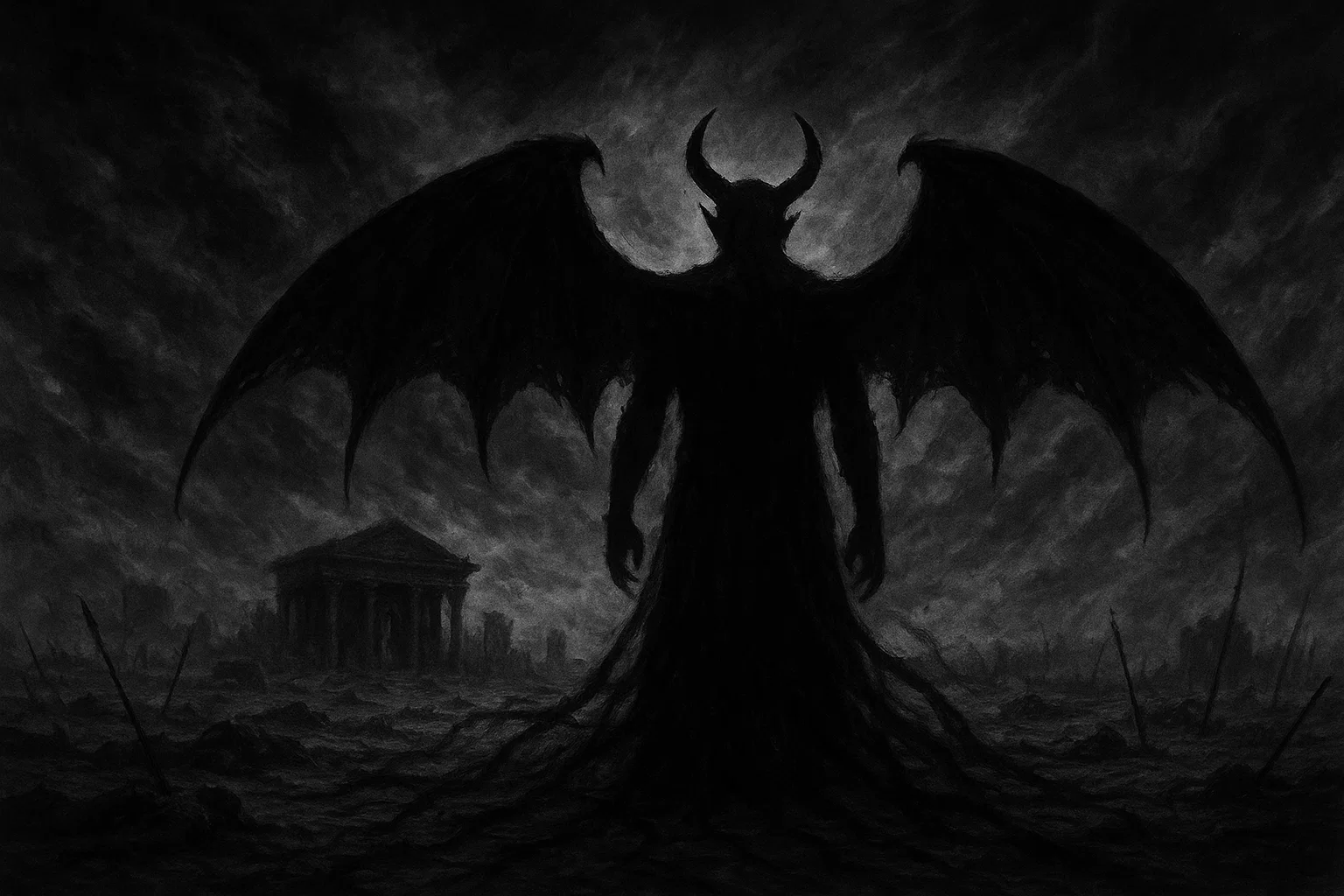In the shadowy depths of ancient demonology, Anamelech lurks as a harbinger of doom, a demonic entity whose very name evokes visions of lunar deception and unrelenting corruption. This insidious demon, Anamelech, often shrouded in the pale glow of the moon, has haunted human imagination for millennia, tempting souls with whispers of inevitable misfortune. Have you ever gazed at the night sky and felt an inexplicable chill, as if unseen eyes were watching, plotting your downfall?
What secrets does this demon hold, born from the fusion of forgotten Mesopotamian gods and Judeo-Christian fears? Could a simple bird like a quail mask a force capable of unraveling empires and ensnaring the innocent in webs of despair?
As we delve into the lore of Anamelech’s powers and its malevolent influence, questions arise: How does this lunar fiend corrupt the hearts of men, and what ancient rituals once fed its insatiable hunger for sacrifice? These enigmas draw us deeper into the abyss, where Anamelech reigns as a master of illusion and bearer of ill tidings, forever opposing the light with its dark temptations.
Table of Contents
Key Information
| Attribute | Details |
|---|---|
| Name | Anamelech, Anammelech, Anamalech, Anomylech, Anu-malik, Anammelek |
| Title | Bearer of Ill News, Lunar Demon, Moon Fiend, Whisperer of Despair, Corrupter of Visions |
| Gender | Male (predominantly depicted as such in demonological texts; some ancient sources suggest female aspects linked to lunar goddesses) |
| Role | Messenger of doom, tempter through deceptive visions, inducer of despair, recruiter of souls for infernal realms |
| Hierarchy | Archdemon minion under Satan; twin counterpart to Adramelech; mid-tier in Hell’s structure, serving as a specialized agent for psychological corruption |
| Servitors | Lesser demons of omens and illusions; shadowy imps that amplify visions; no specific named subordinates, but commands spirits tied to lunar eclipses and nightmares |
| Superior Demon | Satan (direct overlord who assigns tasks like soul corruption); Lucifer (in broader infernal councils) |
| Powers | Inducing harrowing visions, bearing prophecies of misfortune, haunting as apparitions, manipulating lunar influences to heighten emotional turmoil |
| Appearance | Primarily a quail with piercing eyes that glow like moonlight; alternatively, a mule symbolizing burdensome secrets; hybrid forms blending avian and equine traits for deceptive subtlety |
| Etymology | Exposure to solar energies, invocations of protective archangels, rituals of illumination, and truth-telling to dispel illusions |
| Associated Figures | Adramelech (solar twin and ally in corruption); Satan (superior and punisher); Cain (victim of temptations); Abel (used in ghostly hauntings); ancient Sepharvites (worshippers through sacrifice) |
| Weaknesses | Exposure to solar energies, invocations of protective archangels, rituals of illumination and truth-telling to dispel illusions |
| Opposing Angel/Saint | Archangel Gabriel (lunar guardian turned protector); Archangel Uriel (banisher of deceptive forces); Saint Michael (supreme foe of demons) |
| Equipment/Tools | Lunar artifacts like silver mirrors for scrying visions; ethereal quills for inscribing dooms; shadowy veils to conceal true intentions |
| Pantheon | Originating from Assyrian/Mesopotamian deities; corrupted into Judeo-Christian demonology; echoes in Canaanite and Semitic mythologies |
Etymology
The name Anamelech carries profound linguistic layers, tracing back to ancient Semitic roots that blend divine kingship with infernal mockery. Primarily derived from “Anu-melech,” it signifies “Anu is king,” where Anu refers to the supreme Mesopotamian sky god, ruler of the heavens and father of lesser deities. This connection implies Anamelech as a fallen echo of celestial authority, twisted into a demonic parody that usurps kingly power for malevolent ends.
Scholars dissect variants like Anammelech or Anamalech, suggesting influences from Hebrew “melech” (king) combined with prefixes evoking benevolence, such as “ana” implying grace or goodness—ironically subverted in demonic contexts to highlight deception.
In some interpretations, it aligns with “Anat-melech,” linking to the Canaanite warrior goddess Anat, proposing a gender-fluid origin where Anamelech embodies a masculine counterpart, corrupting Anat’s fierce protection into lunar temptations. This etymological duality underscores the demon’s ability to shift forms and meanings, much like the moon’s phases.
Further analysis reveals ties to Akkadian and Assyrian languages, where “Anu” symbolizes ultimate sovereignty, and “malik” reinforces rulership. In biblical condemnations, the name appears as a warning against idolatrous worship, transforming a once-revered title into a symbol of abomination.
Rabbinic commentaries expand this, portraying Anamelech as a linguistic trap, luring the unwary with promises of regal insight only to deliver ruin. Comparative linguistics connects it to broader Near Eastern terms for monarchy, such as Ugaritic equivalents, emphasizing how cultural exchanges morphed gods into demons.
This rich etymology not only illuminates Anamelech’s origins but also its role in demonological hierarchies, where names encode power dynamics. By invoking “Anu is king,” summoners risk affirming the demon’s false dominion, a subtle corruption that begins with words and escalates to soul-binding pacts. Exploring these roots reveals Anamelech as a linguistic shapeshifter, adapting across eras to perpetuate its evil influence.
You May Also Like: Smile for the Dead Girl | Horror Story
What Does the Demon Anamelech Look Like?
Anamelech manifests in forms that embody subtlety and deception, often appearing as a quail—a small, ground-dwelling bird with mottled feathers that blend into shadows, its beady eyes gleaming with unnatural moonlight. This avian guise allows the demon to approach undetected, pecking at the edges of sanity with ill omens. Distinct traits include elongated wings that whisper like wind through graves and a beak curved for inscribing curses in the earth.
In alternative depictions from rabbinic lore, Anamelech assumes the shape of a mule, a sturdy beast burdened with secrets, its hooves leaving trails of frost under lunar glow. This form highlights endurance in delivering despair, with a mane tangled like thorny vines and eyes reflecting victims’ deepest fears. Hybrid variations combine quail head with mule body, symbolizing the demon’s dual nature—fragile yet persistent in corruption.
Such appearances lack overt ferocity, favoring infiltration over confrontation, making Anamelech a master of psychological terror rather than physical might.
Historical and Mythological Background
Anamelech emerges from the murky origins of ancient Near Eastern religions, where it began as a lunar deity in Assyrian and Mesopotamian pantheons, revered yet feared for its changeable nature. Worshipped in Sepharvaim, a twin-city complex along the Euphrates, the demon’s cult involved horrific child sacrifices by fire, believed to appease its demands for cattle prosperity and avert lunar-induced calamities. This practice, condemned in biblical texts, marks Anamelech as a corrupter of innocence, demanding blood for illusory blessings.
Connections to other deities abound, linking Anamelech to Anu, the Mesopotamian sky father, whose kingly essence it perverts. Parallels exist with Sin, the Babylonian moon god, sharing associations with cycles of madness and fertility gone awry.
In Canaanite mythology, ties to Anat suggest a warped sibling relationship, where Anamelech twists her warrior spirit into nocturnal predation. Globally, echoes appear in Egyptian Khonsu, a moon god with healing turned harmful, or Hindu Chandra, whose phases influence demonic possessions in folklore.
Further afield, Anamelech resonates with Celtic lunar entities, such as the Morrigan, harbingers of war and fate, or Native American trickster spirits that employ illusions to create chaos. In demonology, it aligns with Goetic figures like Decarabia, sharing avian forms and visionary powers. These links illustrate how Anamelech absorbed traits from conquered cultures, evolving from god to demon through monotheistic lenses.
The Temptation and Torment of Cain
In a chilling legend, Anamelech acts as Satan’s envoy to claim Cain’s soul post-fratricide. The demon conjures a vision of Cain’s descendants enslaved in eternal toil, while Seth’s lineage basks in opulence. This illusion ignites jealousy, pushing Cain toward deeper sin. Awakening in anguish, Cain flees, but Anamelech pursues, manifesting as Abel’s ghost to haunt him with remorseful apparitions.
These spectral torments drive Cain to isolation, where the demon whispers promises of redemption through infernal allegiance. Satan’s fury at partial failure leads to Anamelech‘s punishment in icy flames, yet the demon persists, using Cain’s guilt to corrupt his bloodline. Interactions with Abel’s shade highlight Anamelech‘s mastery of familial bonds as weapons.
You May Also Like: The Dover Demon Mystery: Still Unsolved?
Worship and Sacrifices in Sepharvaim
Sepharvites honored Anamelech with altars ablaze, sacrificing children to ensure lunar favor over herds. Paired with solar Adramelech, the duo demanded balanced offerings—moon for night protection, sun for day vitality. Transplanted to Samaria by Assyrian conquerors, these rites clashed with Hebrew monotheism, branding Anamelech as an abomination.
Legends describe priests invoking the demon during eclipses, where it appeared to devour offerings, granting false prophecies that led to societal downfall. Interactions with Adramelech involved ritual duels, symbolizing celestial conflicts that mirrored human wars.
Rabbinic Whispers to the Innocent
Rabbinic tales depict Anamelech as a mule whispering forbidden secrets to sleeping children, foretelling Satanic corruption in their futures. This act, born of contempt for its master, invites punishment, yet the demon revels in sowing early seeds of doubt. One story involves a child oracle corrupted into a false prophet, leading villages to ruin.
Interactions with Satan reveal hierarchical tensions, with Anamelech‘s defiance earning torturous reprisals, reinforcing its role as a rebellious yet loyal minion.
Fallen Angel Origins and War in Heaven
As a fallen angel, Anamelech participated in the celestial rebellion, using illusions to deceive loyal hosts. Banished alongside Adramelech by Uriel and Raphael, it descended into Hell, forging alliances through cunning. Legends connect it to pre-flood watchers, tempting humanity with lunar knowledge turned wicked.
You May Also Like: Who Is Abezethibou? The Fallen Angel of the Red Sea
Modern Echoes in Folklore and Pop Culture
In contemporary lore, Anamelech appears in tales of haunted moons, inspiring stories where it possesses dreamers, driving them to self-destruction. Pop culture depictions, such as in horror novels where it summons apocalyptic visions or video games portraying it as a boss inducing madness, expand its influence. Connections to lunar demons in global myths, like Japanese yokai or African spirits, broaden its corruptive reach.
Historical Mentions
| Text/Grimoire | Year | Description | Excerpt |
|---|---|---|---|
| Hebrew Bible (2 Kings 17:31) | c. 6th century BCE | Lunar deity worshipped with child sacrifices alongside Adramelech, symbolizing moon-sun duality in Sepharvaim. | “and the Sepharvites burnt their children in fire to Adrammelech and Anammelech, the gods of Sepharvaim.” |
| Rabbinic Traditions | c. 3rd-5th century CE | Demon whispering secrets to children, punished by Satan for revealing infernal plans. | “Anamelech whispers to the young in slumber, foretelling the Devil’s grasp upon their lives.” |
| Infernal Dictionary | 1818 | Bearer of ill news, lunar counterpart to Adramelech, appearing as quail to deliver omens. | “Anamelech, the moon demon, reveals itself in the form of a quail, carrying tidings of woe.” |
| Encyclopedia of Demons | 2012 | Obscure archdemon involved in Cain’s torment, worshipped through sacrifices for welfare. | “Anamalech was the demonic bearer of ill news, primarily worshipped at Sepharvaun.” |
Anamelech’s Powers and Abilities
Anamelech’s powers focus on psychological warfare, setting it apart from brute demonic forces. As a bearer of ill news, it delivers prophecies that twist fate, inducing despair that leads to sin. Unlike common possessions, its visions are personalized, exploiting fears to corrupt gradually.
In legends, Anamelech haunts with apparitions, appearing as lost loved ones to foster guilt and isolation. Lunar manipulation amplifies emotions during full moons, heightening vulnerability to temptation. Newer depictions in pop culture add abilities like mind-linking, where it connects followers’ thoughts for collective corruption, or summoning mystic armor from shadows.
These abilities of Anamelech corrupt by eroding faith, turning hope into heresy. In modern horror tales, it induces digital hallucinations, adapting ancient visions to contemporary fears, ensuring its malevolence evolves.
Powers and Abilities Breakdown
| Power/Ability | Description | Source | How It Tempts/Corrupts Humans | Countermeasure |
|---|---|---|---|---|
| Vision Projection | Crafts illusions of future suffering tailored to victims. | Biblical legends | Fuels envy and violence, as with Cain’s jealousy. | Archangel Gabriel’s clarity prayers. |
| Ill Omen Delivery | Whispers dooms in disguised forms, causing panic. | Rabbinic tales | Erodes trust in goodness, leading to pacts. | Solar rituals with Saint Michael. |
| Apparition Haunting | Manifests as ghosts to torment with guilt. | Folklore | Isolates individuals, prompting self-harm. | Exorcisms focusing on repentance. |
| Lunar Emotional Surge | Intensifies melancholy tied to moon phases. | Mesopotamian worship | Heightens sins during cycles, corrupting routines. | Blessed silver talismans. |
| Mind-Linking | Connects minds for shared deceptions. | Modern depictions | Builds cults through collective delusions. | Group invocations of light. |
How to Counter Anamelech’s Powers
Countering Anamelech requires piercing its veil of deception with truth and light. Solar invocations dispel lunar illusions, using sunlight or fire to weaken visions. Archangel Gabriel, as lunar overseer, clarifies deceptions through meditative prayers.
Repentance rituals banish apparitions, while communal faith combats isolation. Protective circles with salt and herbs like nightshade (inverted for good) form barriers. In extreme cases, exorcisms invoking Uriel’s banishing flames purge influence, transforming temptations into spiritual strength.
You May Also Like: Is Ahriman the Oldest Demon in History?
Anamelech’s Role in the Hierarchy of Hell
In Hell’s rigid structure, Anamelech serves as a mid-tier archdemon, directly under Satan as a specialized minion for soul recruitment via deception. It rules shadowy lunar domains, overseeing realms of nightmares and eclipses where tormented souls relive illusions.
Armies include legions of omen spirits and illusory imps, numbering in the thousands, deployed for mass temptations. Notable subordinates: Shadowy whisperers amplifying despair. Superiors: Satan (punisher), Lucifer (council head). Allies: Adramelech (twin, solar complement for dual assaults); Asmodeus (shared temptation tactics).
Adversaries: Beelzebub (rival for influence); Belial (clashing over discord methods). This position allows Anamelech to navigate infernal politics, using cunning to ascend while serving as Satan’s wardrobe aide in mockery.
Astrological Associations and Symbolism
Anamelech ties deeply to lunar astrology, influencing emotions and hidden malice. Associated with the moon planet, it thrives in Cancer zodiac, amplifying intuitive corruption. Elements: Water for fluid deceptions, earth for grounded burdens.
Metals: Silver, evoking cold moonlight. Crystals: Moonstone for visionary traps, pearl for deceptive purity. Colors: Pale blue, midnight silver. Numbers: 9 (cycles), 28 (lunar month). Days: Monday, for nocturnal schemes. Planets: Moon primary, Neptune secondary for illusions.
Symbolism extends to changeable phases, representing instability in human affairs.
| Association | Details |
|---|---|
| Element | Water, Earth |
| Number | 9, 28, 13 |
| Day | Monday, eclipse nights |
| Metal | Silver, lead |
| Stone/Crystal | Moonstone, selenite, black pearl |
| Color | Silver-gray, deep indigo |
| Zodiac | Cancer, Pisces |
| Planet | Moon, Neptune |
Anamelech’s Sigil
Traditional grimoires lack a specific sigil for Anamelech, its obscurity leading to modern adaptations using crescent moons encircled by quail motifs. These symbols, etched in silver, aid in forbidden summons but risk backlash.
Associated Symbols and Offerings
| Symbol/Item | Association/Meaning | Use in Rituals |
|---|---|---|
| Quail Feather | Subtle omens, deception | Burned for visionary curses; scattered for protection wards |
| Mule Hoof | Burdened secrets, persistence | Carved into talismans for endurance in temptation |
| Moonstone | Lunar intuition, hidden malice | Charged under full moon for illusion spells |
| Myrrh Incense | Mourning, veiled truths | Smoked to invoke despair or banish hauntings |
| Nightshade Plant | Poisonous mystery, corruption | Infused in potions for dream torments or antidotes |
| Owl | Nocturnal wisdom, foreboding | Feathers used in offerings for prophetic evils |
Comparison with Other Demons
| Demon | Role | Hierarchy | Powers | Appearance |
|---|---|---|---|---|
| Adramelech | Chancellor, wardrobe supervisor | High council president | Fire blasts, light projection | Mule-headed peacock |
| Asmodeus | Lust tempter, destroyer | Prince commanding legions | Relationship ruin, arts teaching | Three-headed beast |
| Belphegor | Sloth inducer, inventor | Ambassador | Laziness inspiration, wealth offers | Horned on toilet |
| Astaroth | Sciences teacher | Duke | Past/future revelation | Crowned on dragon |
| Beelzebub | Disease lord, gluttony | Prince second to Satan | Possession, fly swarms | Bloated fly figure |
| Leviathan | Envy sea monster | Admiral | Heresy temptation, tsunamis | Serpentine dragon |
| Mammon | Greed corrupter | Treasurer | Riches corruption | Gold-armored |
| Belial | Vice sower, lawless | King without master | Discord, title grants | Fiery chariot |
| Abaddon | Apocalypse destroyer | Abyss angel | Locust leadership | Winged warrior |
| Lilith | Child-killer, seductress | Night queen | Infant strangling, men temptation | Winged serpent-woman |
You May Also Like: Alastor: Greek Avenger Turned Executioner of Hell
Conclusion
Anamelech, the lunar demon of ill news and visionary torment, stands as a chilling reminder of how subtlety can outmatch overt evil in corrupting souls. Its ancient origins and modern echoes underscore a timeless threat, urging eternal vigilance against deceptive whispers.
In reflecting on Anamelech‘s legacy, we confront the fragility of the human spirit, tempted by illusions that promise knowledge but deliver damnation. This exploration illuminates the demon’s profound impact, a force forever lurking in shadows, ready to ensnare the unwary.






